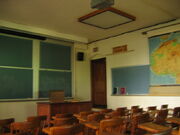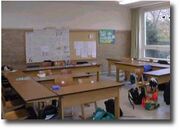Assessment |
Biopsychology |
Comparative |
Cognitive |
Developmental |
Language |
Individual differences |
Personality |
Philosophy |
Social |
Methods |
Statistics |
Clinical |
Educational |
Industrial |
Professional items |
World psychology |
Educational Psychology: Assessment · Issues · Theory & research · Techniques · Techniques X subject · Special Ed. · Pastoral

A university classroom with permanently-installed desk-chairs and green chalkboards.
A classroom is a room in which a lesson is taught by a teacher in a school or other educational institution. Classrooms may be associated with a particular subject, particularly in the cases where specific resources are required, or with a specific teacher. In the latter situation a teacher, and often the students in schools for early years, may have all their lessons in that room. The other scenario sees the room shared by more than one teacher and each teacher works at different times.
Learning environment[]
A classroom is supposed to provide an appropriate learning environment for the students, including the seating arrangements and location of resources as well as other environmental aspects such as lighting and temperature, though exact requirements may vary greatly according to country or economic restraints.

Classroom of a secondary (high) school in Germany
Most classrooms have some form of large writing surface on which the teacher or instructor can make notes for the class to see. Traditionally this was in the form of a blackboard though these are becoming less common in affluent schools, replaced by flipcharts, whiteboards and interactive whiteboards. Many also have a method of projecting slides or information.
Many places can be used as an informal classroom, and this is quite necessary for lessons that require specific resources or a vocational approach. This is known as situated learning.
Classroom Etiquette[]
There are a wide variety of cultural norms associated with traditional classrooms, mostly oriented towards what the students are prohibited from doing in the classroom. These include:
- Speaking without permission
- Passing notes to other students
- Chewing gum, eating or drinking
- Wearing hats or caps in the classroom (likely because this is considered to be disrespectful to the teacher)
- Engaging in any activity other than paying attention to the teacher
While many of these rules have a sound rationale behind them, the pragmatic impact of a wide assortment of behavorial prohibitions against the students during class, despite their beneficial impact, can have a cumulative, if unintended, oppressive impact. This is particularly the case with rules such as that against wearing hats or caps, which cannot be reasonably defended as protecting the learning environment, and is merely a way to subordinate the students' will to that of the teacher's, for no purpose other than as an exercise of petty authority.
This seemingly minor issue can manifest significant importance in issues such as where a religious practice dictates wearing a hat or other head covering, which is arbitrarily banned by classroom rules.
See also[]
External links[]
| This page uses Creative Commons Licensed content from Wikipedia (view authors). |
